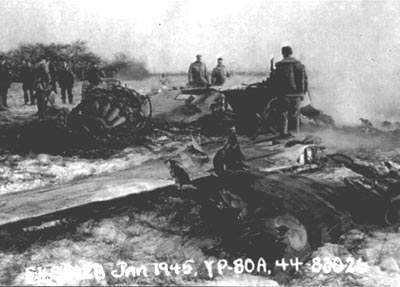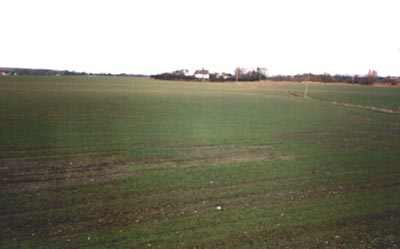 |
YP-80A,
44-83026 - Bold, St Helens
28th January 1945 |
 |
YP-80A,
44-83026 - Bold, St Helens
28th January 1945 |
Last Updated: 16.07.2001
Note: This aircraft is of particular interest as it was one of only two US service prototype jets in England, and one of the four such aircraft that were sent to Europe on the orders o General H. H. Arnold. The aim being to demonstrate their capabilities to combat crews, to help in the development of tactics against Luftwaffe jet fighters and help improve morale.
| Type | Unit | Base | Duty | Crew |
| YP-80A | Air Service Command |
BAD 1, Burtonwood | Test Flight | 1 |
On the 28th January 1945 at 11:40 hours 28 year old, Major Frederic Austin Borsodi 0-420960 of the Air Technical Service Command HQ, based at Wright Field, USA, took off from Burtonwood using runway 27 on a routine test flight in Lockheed YP-80A Shooting Star 44-83026 (cn 1005). This was the aircraft's second test flight and the take off was fast, with the aircraft leaving the traffic pattern in a gradual climb. Major Borsodi then flew in a left hand circuit just beyond the outer boundary of the local control zone at an altitude of between 8,000 to 10,000 feet, while making four or five rolls and the aircraft appeared to function correctly.
|
Major Borsodi in the cockpit of one of the YP-80A's at Burtonwood, January 1945. |
| Name | Position | Status |
| Major Frederic Austin Borsodi 0-420960 | Pilot | K. |
After being airborne for approximately 20 minutes at an altitude of about 4,000 to 5,000 feet and about three miles west of the airfield, black smoke and fire was observed being expelled from the aft section of the aircraft. Immediately thereafter, the rear empennage disintegrated and the aircraft went out of control, crashing right side up, on farmland at Bold at 12:01 hours. The aircraft was then partially consumed by fire, with the crash causing slight damage to the surrounding fences. A P-47 on a routine test flight passed overhead and circled the crash site, to guide the crash crews to its location. Major Borsodi had made no apparent attempt to leave the aircraft and it was assumed that he was unconscious or had already been killed before the aircraft had hit the ground. It was also noted that within an hour of the accident German radio announced the type of aircraft that had crashed and personal information on the pilot!
The incident was seen by a large number of witnesses in the surrounding area, who saw the aircraft conducting various manoeuvres in the vicinity of Burtonwood. Many heard an explosion and saw the tail section on fire, with pieces falling away from the aircraft as far away as Rainhill. The aircraft was observed "falling like a leaf" and to spin and glide until it crashed. A number of the local residents, some living only 200 yards away, immediately ran to the scene and they were soon joined by the local police.
 |
44-83026 Crash Site, January 1945 |
Police Constable William Stark's account was typical of several statements taken and follows below (note: this statement has been edited out of respect to Major Borsodi and his family),
"About 11:55 hours on Sunday, 28th January 1945, I was on motor patrol duty, driving Police patrol van CTJ172, through the Bold area. I was accompanied by PC Alderson. At the time I heard aircraft overhead, one of which was making a peculiar noise, I slowed down, bent down and on looking through my left windscreen I saw an aeroplane flying in a westerly direction. A few seconds later it passed out of my sight. After proceeding a short distance I heard the sound of an explosion and practically at the same time saw some pedestrians who were on the road pointing to the fields over which the plane was flying. PC Alderson said to me " I think that plane has come down". We approached the field that the plane had come down in. The wreckage was in flames, so I turned into the field and drove straight towards the burning aircraft, and stopped about 100 yards away. Whilst proceeding to the scene PC Alderson contacted Billinge Wireless Station and notified them of what had taken place.
We left the van and ran towards the burning wreckage and saw John Ivan Davies and Walter Arnold both of Bold. Davies was shovelling snow and soil into the flames, which were rising into the air. PC Alderson took possession of the spade and using this on the downwind side of the fire, managed to drag Major Borsodi's body from the wreckage with the assistance of myself, Davis and Arnold".
In response to the message sent by PC Alderson, Colonel Soper from Burtonwood arrived at the crash scene shortly afterwards together with a number of personnel and equipment and by spraying foam on the fire, quickly put it out. St Helens AFS arrived on the scene just after the fire had been extinguished, having received a call at 12:09 hours, as there services were not required they immediately left the scene.The site was cleared of all wreckage by 16:00 hours the same day and a party of men was also despatched to collect the trail of debris from the surrounding district.
Following the investigation of the Aircraft Accident Committee, the cause of the accident was found to be that the tail pipe flange failed in tension. This allowed enough exhaust leakage to be released into the aft section of the fuselage to melt of the tail pipe lagging, the tail surface roots, and part of the fuselage aft section skin, causing rear empennage disintegration. It took a further two weeks to determine the exact cause of the in-flight fire. The distribution of all the debris was plotted, which were spread over half a mile in a relatively straight line. The first piece along the flight path was the tail pipe, which displayed evidence of forced separation of its attachment to the engine tail cone. Next in line was the vertical fin and rudder with part of the aft fuselage, this part showed excesive heat and smoke damage. The investigation also revealed "thrown turbine buckets" and it was noted that when these break away, they damage everything in their path, cables, hydraulics' etc, i.e. the engine literally blew up, taking off the rear empennage.
Lockheed YP-80A Shooting Star 44-83026 was built by Lockheed at its Burbank factory in California and was accepted/delivered to the UAAAF on the 4th December 1944 and was disassembled, boxed and shipped as deck cargo to Burtonwood with its sister aircraft 44-83027 on 15th December 1944, arriving on the 30th December 1944. Following the aircraft's arrival at Burtonwood, YP-80s number 004 and 005 took one month to be reassembled, due no doubt to the extremely cold weather. The pilots, Major Frederic Austin Borsodi and Colonel Marcus Cooper arrived in January 1945 and on the 27th, Colonel Cooper took 44-83026 for its first test flight. YP-80, 44-83027 was later destroyed in an accident on the 14th November 1945 testing the B-41 engine, the prototype of the Rolls Royce Nene turbojet. The other two YP-80 aircraft, 44-83028 and 44-83029, sent to Europe as part of this project, headed by Colonel George Price, were shipped to Italy. Even though they flew some operational sorties they never encountered any enemy aircraft, one crashed on 2nd August 1945 after its return to the US, the other ended its useful life as a pilotless drone.
 |
44-83026 Crash Site, March 2001 |
Major F. A. Borsodi served initially as a Second Lieutenant with the 86th Fighter squadron, 79th Fighter Group in the Mediterranean Theatre of operations from 1942 rising to the rank of Captain, then Major and commanding officer of the Squadron up to October 1943. He flew the P-40 " Warhawk" and was credited with shooting down three enemy aircraft and a third share in another, completing some 130 missions in this time. He was sent back to the US and became chief of fighter testing from 1943-45 at Wright Field in Ohio, where he was the first man to witness and film the compressibility shockwave on an aircraft wing while power diving a P-51 Mustang up to Mach 0.84 from nearly 40,000 feet. He was aged 28 at the time of his death and was buried with full military honours at the American Military Cemetery in Cambridge, plot C row 4 grave 73. During his service as a combat pilot he was awarded the Distinguished Flying Cross with three Oak Leaf Cluster and The Air Medal with fifteen Oak Leaf Clusters and the British DFC. Major Borsodi entered the service from Connecticut and left a widow with two young daughters, the youngest only 1 month old. It was believed if Major Borsodi had survived, it is likely he would have gone on to be a test pilot on the supersonic test program.
Acknowledgements:
Mike Stowe of Accident Reports, The Burtonwood Association, Aldon Ferguson. Barbara Borsodi.
References:
Morley, R.A. - Fred Borsodi, Test Pilot and the YP-80. Burtonwood Times, Vol 11, No. 1, Spring 1997.
This page Copyright © Mark Gaskell & Nick Wotherspoon 2001